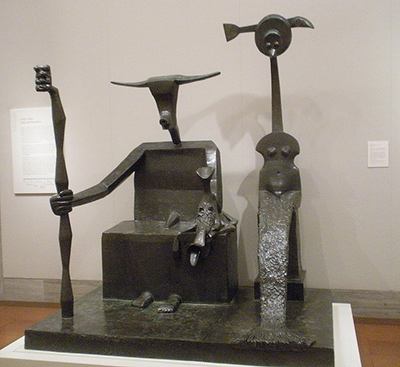Sculpture and painting were closely linked disciplines within the Surrealist movement and Max Ernst was one of many famous names who appreciated who the very hands-on medium of sculpture allowed him to bring his conscious to life in three dimensional forms.
One of the finest examples of the link between Ernst's paintings and sculptures could be the comparison between Capricorn (pictured here) and his oil painting, The Elephant Celebes, both of which include bull horns and influences from African art. To personally hand craft these features would have given the artist a real sense of enjoyment and also leave a more lasting demonstration of the ideas lying deep in his mind rather than the relatively flat painting. As his career developed, knowledge learnt in each of these disciplines could then be used to improve his work in other mediums too. You will see advancements being passed from one to another, and back again over the years in which he continually saught improvement and change.
Max Ernst was an artist who did not desire precision nor clarity in his work. This has proved unfortunate in our efforts to analyse both his surrealist sculptures and paintings. It has also encouraged academics to widen the breadth of the explanations about items in his compositions, more so than perhaps has been helpful. He found sculpture to be fun and a truly experimental medium in which his creativity could be 100% unleashed. For example, for Capricorn which is one of his most famous sculptures, he would make use of a wide variety of materials during the production process including cement and scrap iron with assists from box tops, eggshells, springs, cartons and boxes among others.
There has been a growing interest in exhibiting the sculptures of multi-skilled masters such as Picasso and Ernst. The public have responded with impressive visitor numbers and this has further encouraged venues to provide exhibitions that cover established artists from new directions. Max Ernst would make use of sculpture right across the full span of his career and consistently made use of totem-like symbols. African art seemed to be particularly influential here. He liked to make use of sturdy materials such as bronze, iron and stone. Late in his career this ever-experimenting artist, chose to make use of glass for the first time and even produced a series of chess pieces from that. His work for Capricorn was re-used in a number of different formats once initially completed, which is one of the advantages found within sculpture, particularly where moulds can be re-used several times, in a similar way to the processes of etching and woodcut prints.
The medium of sculpture would undergo somewhat of a re-imagination during the 20th century, after long being seen as something that peaked during ancient civilisations and then again in Renaissance Italy. It was now that a number of painters would bring their creative ideas to this format for the first time, in conjunction with some others who pretty much specialised in sculpture. Rodin, for example, would modernise sculpture with his lifelike depictions and extraordinary attention to detail in which he would emotionally connect with both the model and the resultant sculpture. It was a form of obsession which was entirely necessary for the purposes of achieving the highest possible standard of work. Max Ernst was clearly different from that in how he approached this art form, bearing more similarities to those who extended their careers into sculpture, rather than specialising in it. The likes of Miro, Degas and Picasso are good examples of that.
Max Ernst's sculptures have not yet received the attention that they undoubtably deserve, with exhibitions focused on them being extremely rare. That said, there has been a greater interest in promoting the full oeuvre in different artist's careers in recent years and so it is more likely that some of these items will pop up more frequently in future displays, possibly alongside some of his drawings. There was a small exhibition in around 2015 which showed around 14 of the artist's sculptures, all of which were made from bronze and limestone. This was staged at the Paul Kasmin Gallery, but this event was a rarity in drawing specific attention to his work in this particular medium. With his work in this medium being relatively small, to see 14 sculptures is actually quite a significant number of his overall output and so that would have been an excellent event to attend for those interested in this section of his career. Hopefully, further similar displays will be arranged in future years in various locations across the US and Europe, so that more of us can see some of these pieces.




